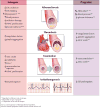Contraceptive hormone use and cardiovascular disease
- PMID: 19147038
- PMCID: PMC2660203
- DOI: 10.1016/j.jacc.2008.09.042
Contraceptive hormone use and cardiovascular disease
Erratum in
- J Am Coll Cardiol. 2009 Mar 10;53(10):904
Abstract
Contraceptive hormones, most commonly prescribed as oral contraceptives (OCs), are a widely utilized method to prevent ovulation, implantation, and, therefore, pregnancy. The Women's Health Initiative demonstrated cardiovascular risk linked to menopausal hormone therapy among women without pre-existing cardiovascular disease, prompting a review of the safety, efficacy, and side effects of other forms of hormone therapy. A variety of basic science, animal, and human data suggests that contraceptive hormones have antiatheromatous effects; however, relatively less is known regarding the impact on atherosclerosis, thrombosis, vasomotion, and arrhythmogenesis. Newer generation OC formulations in use indicate no increased myocardial infarction risk for current users, but a persistent increased risk of venous thromboembolism. There are no cardiovascular data available for the newest generation contraceptive hormone formulations, including those that contain newer progestins that lower blood pressure, as well as the nonoral routes (transdermal and vaginal). Current guidelines indicate that, as with all medication, contraceptive hormones should be selected and initiated by weighing risks and benefits for the individual patient. Women 35 years and older should be assessed for cardiovascular risk factors including hypertension, smoking, diabetes, nephropathy, and other vascular diseases, including migraines, prior to use. Existing data are mixed with regard to possible protection from OCs for atherosclerosis and cardiovascular events; longer-term cardiovascular follow-up of menopausal women with regard to prior OC use, including subgroup information regarding adequacy of ovulatory cycling, the presence of hyperandrogenic conditions, and the presence of prothrombotic genetic disorders is needed to address this important issue.
Conflict of interest statement
Figures


References
-
- Chandra A, M G, Mosher WD, Abma JC, Jones J. Fertility, Family Planning, and Reproductive Health of U.S. Women: Data from the 2002 National Survey of Family Growth. National Center for Health Statistics. Vital Health Stat. 2005;23 - PubMed
-
- Margolis KL, Adami HO, Luo J, Ye W, Weiderpass E. A prospective study of oral contraceptive use and risk of myocardial infarction among Swedish women. Fertil Steril. 2007;88:310–6. - PubMed
-
- Kaunitz AM. Clinical practice. Hormonal contraception in women of older reproductive age. N Engl J Med. 2008;358:1262–70. - PubMed
-
- DeStefano F, Merritt RK, Anda RF, Casper ML, Eaker ED. Trends in nonfatal coronary heart disease in the United States, 1980 through 1989. Arch Intern Med. 1993;153:2489–94. - PubMed
-
- Bairey Merz CN, Johnson BD, Sharaf BL, et al. Hypoestrogenemia of hypothalamic origin and coronary artery disease in premenopausal women: a report from the NHLBI-sponsored WISE study. J Am Coll Cardiol. 2003;41:413–9. - PubMed
Publication types
MeSH terms
Substances
Grants and funding
LinkOut - more resources
Full Text Sources
Medical

